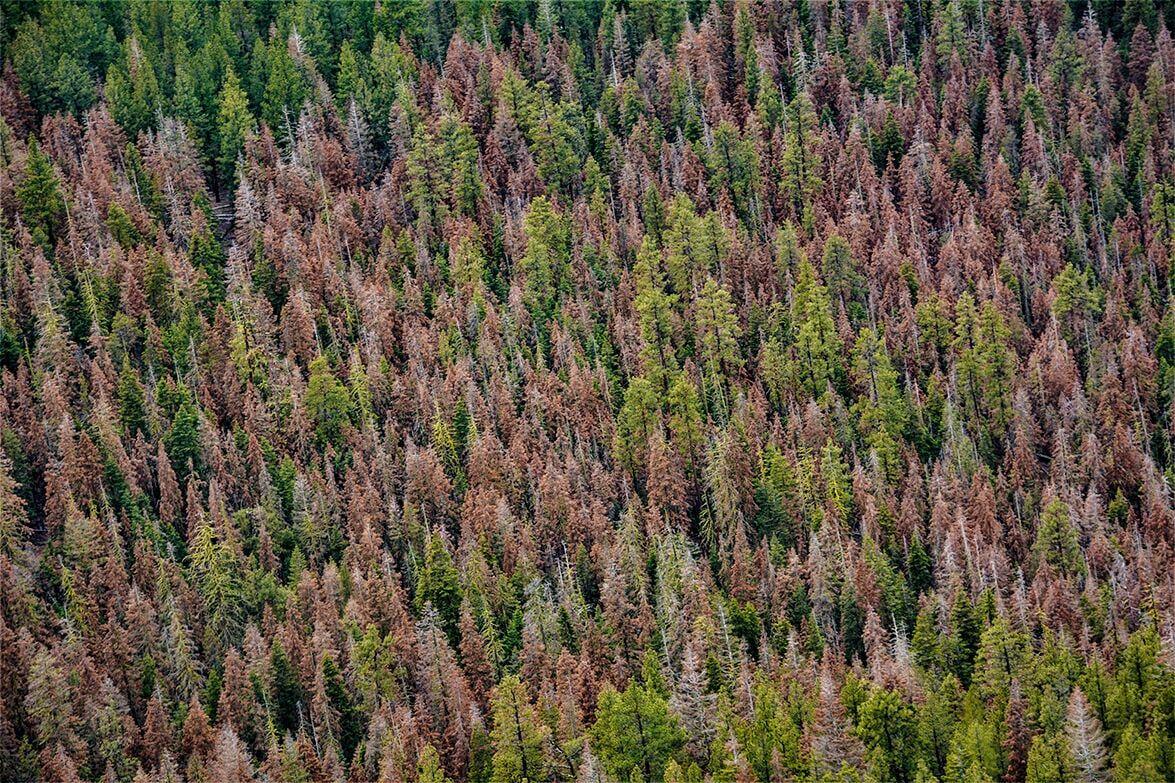This article was published on: 12/15/22 3:37 PM
PORTLAND — Years of drought are taking a toll on Oregon’s iconic fir trees.
Aerial surveys led by the U.S. Forest Service and Oregon Department of Forestry found a record high mortality rate for fir trees in 2022, particularly in parts of Central and Southern Oregon that have endured the most severe drought.
Daniel DePinte, aerial survey coordinator for the Forest Service in the Pacific Northwest Region, estimated 1.1 million acres with dead or dying firs statewide — twice as many as any other year dating back to 1952, when the agency started keeping records.
Every year, the Forest Service flies over 69 million acres of forestland in Oregon and Washington to document forest health. The Oregon Department of Forestry and Washington Department of Natural Resources also assist with the surveys.
It was DePinte’s colleague in the plane who coined the term “firmageddon,” as they observed entire landscapes intermixed with brown, dead trees.
Drought underpins mortality
The most significant damage occurred in dry forests east of the Cascade Range, including the Ochoco, Malheur and Fremont-Winema national forests, according to the survey.
“It seems to correlate exactly where the Drought Monitor has mapped severe to exceptional drought conditions,” DePinte said.
Christine Buhl, Oregon state forest entomologist, said the increasing intensity of hot summers and drought underpins mortality. As the lack of moisture stresses the trees, it reduces their defenses against insects and fungal diseases.
For example, stressed firs might not be able to summon the moisture and sap they would normally use to suffocate or eject bark beetles.
Compared to species such as ponderosa pine, fir trees are not as drought-tolerant and are especially vulnerable to hot, dry weather.
“We see dead trees every year. We have peaks and declines every year,” Buhl said. “It’s surprising, on one hand, to see so much mortality so suddenly, but not surprising when you consider what it is correlating to.”
So far, the “firmageddon” appears to be an Oregon-centric issue. This year’s survey of Washington forests showed approximately 69,000 acres of dead trees, which is slightly elevated, though DePinte said surveyors have seen much worse.
Adapting management
If hotter, longer droughts are the new norm, Buhl said forest managers will need to adapt.
That may involve planting more drought-tolerant pines, or changing when firs are planted during reforestation. By planting in the fall instead of the spring, for example, it may allow seedlings to absorb more moisture from the ground before summer, she said.
More thinning may also be needed to reduce the risk of wildfires, while eliminating invasive species such as Scotch broom or Himalayan blackberry, which rob moisture from trees.
“If we adapt to changing conditions, about what species we expect to be growing where and at what density, we’re going to be in better shape,” Buhl said.
Though not a true fir species, Douglas firs are also struggling in some areas, Buhl said. She acknowledged that for private timberlands and small woodland owners, Douglas fir remains king for producing lumber and other building materials.
Knowing that markets drive change, Buhl said more research is needed to develop wood products using other species.
DePinte said land managers should be thinking critically about what forests will need to look like 100 years from now in certain areas, given the impacts of climate change.
“In my mind, the forests are moving,” he said. “Nature is directing it. It’s selecting different species. Drought and climate change (are) selecting which trees get to be where.”
Private forestland
Kristin Rasmussen, a spokeswoman for Hampton Lumber, said the company has experienced some losses of fir trees, largely due to the “heat dome” in 2021 that brought triple-digit temperatures to the region June 24-29.
However, Rasmussen said die-off is not nearly as bad as that seen on federal land.
“We’ve known for a long time that our federal forests are unhealthy and in need of treatment — that is to say, strategic harvesting to thin key areas and use of controlled burns,” she said. “Climate change is exacerbating conditions and the ramifications of inaction.”
About 60% of forestland in Oregon is owned by the federal government. Private ownership accounts for 34% of forests, while yielding 76% of the state’s total timber harvest.
Seth Barnes, director of forest policy for the Oregon Forest Industries Council — a trade association representing more than 50 forestland owners and wood products manufacturers — said private forests are faring better because they can be thinned and managed more proactively.
“When you hamstring (agencies) with layers of bureaucratic red tape and lawsuits from environmental organizations, they can’t get the job done,” Barnes said.
More dead trees on public lands also poses a greater wildfire risk, Barnes said, since the blazes can quickly spread onto private forests.
“That’s a big concern for us,” he said.
Rasmussen, of Hampton Lumber, said the dead trees on federal lands should be prioritized for salvage within the next year or two, so they can be turned into useful wood products before insects and decay set in.
“Leaving them in the woods just creates more opportunity for disease and wildfire to spread out of control,” she said.
-George Plaven




